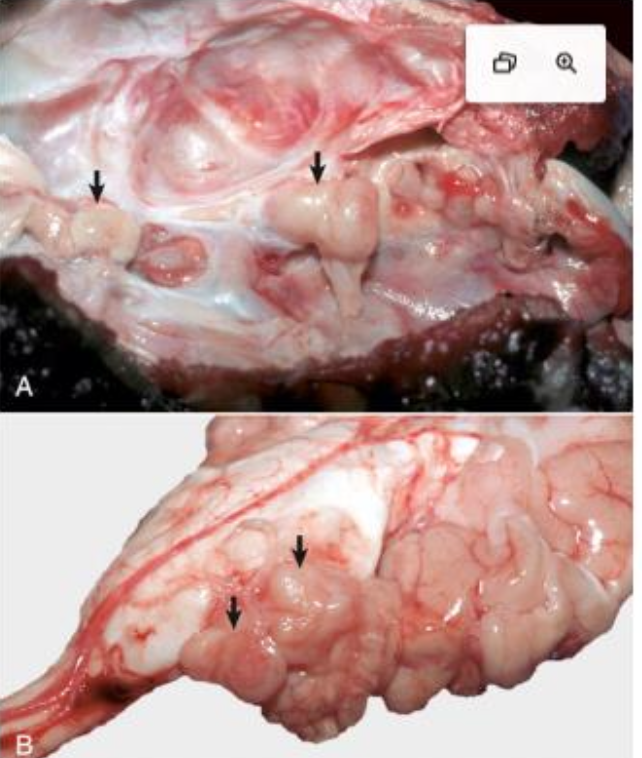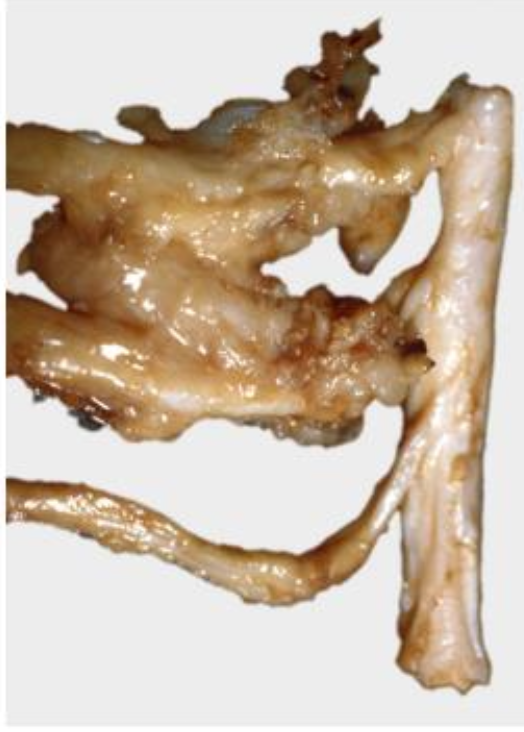Lecture 63: Peripheral Nervous System
1/34
There's no tags or description
Looks like no tags are added yet.
Name | Mastery | Learn | Test | Matching | Spaced |
|---|
No study sessions yet.
35 Terms
What is the difference between myelinated and unmyelinated axons?
myelinated: rapid signal transmission
unmyelinated: slow, continuous signaling (autonomic/sensory)
What is the function of the PNS?
connect the CNS to the rest of the body, enabling both sensory input (afferent) and motor output (efferent)
What is the difference between the somatic and autonomic nervous sytems?
somatic: controls voluntary skeletal muscle movement via spinal and cranial nerves
autonomic: controls involuntary functions
How is the autonomic nervous system further divided?
PSNS: rest and digest
SNS: fight or flight
enteric: regulates GI motility and secretion via myenteric and submucosal plexuses
What is axoplasmic transport and what are the two different types?
bidirectional movement of nutrients and molecules:
anterograde: cell body → axon terminal
retrograde: axon terminal → cell body
What allows rapid signal propagation through depolarization waves?
action potentials
Myelination by ________ provides insulation and trophic support to the PNS?
schwann cells
What cranial nerve arises from the rostral olfactory bulb?
CN 1 (olfactory)
What cranial nerve arises from the forebrain?
CN II (optic)
What cranial nerve arises from the brainstem?
CN III-XII:
• CN III and IV – arise from the midbrain
• CN V-XII – emerge from the pons and medulla oblongata
• Myelinated by Schwann cells (unlike CN I and II)
What cranial nerves are sensory, motor, and mixed?
• Sensory: I, II, VIII
• Motor: III, IV, VI, XI, XII
• Mixed: V, VII, IX, X
How is the enteric system divided?
• Myenteric plexuses: located in muscle wall – helps with motility
• Submucosal plexuses: Submucosal – aids digestion fluid secretion and absorption, blood flow
What cells in the ganglia provide metabolic and structural support?
satellite glial cells
What is the endoneurium, perineurium, and epineurium?
Endoneurium – surrounds individual nerve fibers
Perineurium – encloses nerve fascicles
Epineurium – encases groups of fascicles
The dorsal rot relays _______ information, while the ventral root relays ______ information.
sensory, motor
What is dysautonomia and what are some examples?
failure of the autonomic nervous system:
equine grass sickness in horses
Key-Gaskell syndrome in cats
What are the causes and clinical signs of dysautonomia?
causes: autoimmune or environmental toxins
clinical signs: GI stasis, urinary incontinence, bradycardia, prolapsed third eyelid, mydriasis
What is peritonitis-induced autonomic dysfunction?
cytokine-mediated degeneration of enteric neurons in the myenteric and submucosal plexuses → neuronal chromatolysis, edema of nerve fiber bundles, and supporting cell hyperplasia
What is congenital hypomyelinating polyneuropathy?
a mutation in the MPZ gene in golden retrievers → thin myelin sheaths, excess (pos. defected) schwann cells → hopping gait, decreased reflexes, limb circumduction
What is coyotillo toxicosis in ruminants?
toxicity from karwinol A from karwinskia humboldtiana fruit → primary demyelination targeting schwann cells → hindlimb weakness incoordination
What are some endocrine related neuropathies?
Diabetes mellitus: Causes diabetic neuropathy (rear limb weakness, plantigrade stance (flat hock) in cats).
Hypothyroidism: Can produce sensory and motor deficits.
Pathogenesis involves metabolic and vascular changes to nerves.
What are some nutritional neuropathies?
Vitamin A deficiency: Optic nerve compression → blindness (calves, pigs).
Riboflavin (B2) deficiency: “Curled-toe paralysis” in poultry—demyelination and endoneurial edema
What are some toxic neuropathies?
Lead: Neuronal necrosis (CNS) + demyelination (PNS).
Organomercurials: Damage dorsal root ganglia neurons.
Vincristine: Chemotherapy agent disrupting microtubules → distal axonal degeneration.
Ionophore toxicosis (salinomycin in cats): Polyneuropathy with axonal degeneration and demyelination
How does botulism cause PNS disease?
clostridium botulinum neurotoxin (types A-G) in horses, cattle and birds → blocks ACh release at neuromuscular junction → flaccid paralysis → death via respiratory vailure
What are the types of traumatic nerve injury?
Neurapraxia: Temporary conduction block (recoverable).
Axonotmesis: Axon destroyed but connective tissue intact (good prognosis)
What is neuroma?
bulbous regrowth after nerve severance (ex. tail dock neuroma)
How does neurogenic shock occur?
secondary to CNS trauma → autonomic dysfunction → vasodilation → hypotension → shock
What are the three types of nerve sheath neoplasms?
schwannoma: most common in dogs
neurofibroma
perineurioma

What is this?
schwannoma

What is this? note the thickening of spinal nerve roots and fibers with tan brown tissue.
spinal nerve schwannoma
How does equine grass sickness affect horses?
loss of enteric and autonomic neurons → gut stasis and dsyphagia → distended GI tract, esophagitis from reflux
How does recurrent laryngeal paralysis (“roaring”) occur in horses?
axonal injury of the recurrent laryngeal nerve (left side more common in tall male horses), leading to neurogenic atrophy of the cricoarytenoid dorsalis muscle → inspiratory noise, exercise intolerance
How does polyneuritis equi (cauda equina neuritis) affect horses?
suspected autoimmune disorder targeting sacrococcygeal nerves → granulomatous inflammation and fibrosis around affected nerves → tail and perineal paralysis, urinary/fecal incontinence, pelvic muscle atrophy
How does acute idiopathic polyneuritis (coonhound paralysis) affect dogs?
autoimmune demyelination of ventral spinal roots and peripheral nerves → ascending flaccid paralysis (hindlimbs to forelimbs), hyperesthesia, weakness
How does sensory neuropathy of english pointers occur?
hereditary sensory neuropathy → degeneration of dorsal root ganglia and spinal nerves → insensitivity to pain, self-mutilation of paws